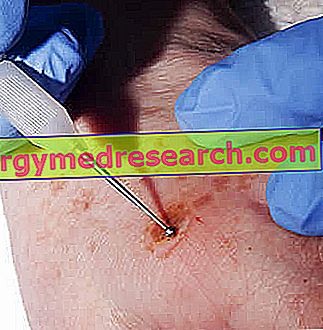Generality
Diathermocoagulation - also known as electrocoagulation - is a particular technique, used in the dermatological field to remove small portions of epidermal tissue, in order to treat and resolve certain types of skin diseases and disorders.

Diathermocoagulation is considered a very effective technique, which can be performed relatively quickly and whose results are always satisfactory.
Indications
As mentioned, the diathermocoagulation is used above all in the dermatological and gynecological field.
Use in Dermatology
More in detail, in dermatology this technique is used for the treatment and / or removal of:
- Various types of warts;
- Pendulous fibromas;
- in;
- Some types of stellate angiomas;
- Ruby Angiomas;
- Seborrheic or actinic keratosis;
- blotches;
- Ecstatic venous capillaries;
- freckles;
- Freckles.
Use in Gynecology
In the gynecological field, on the other hand, diathermocoagulation is mainly used for the removal of condylomata acuminata, also known as "venereal warts" or "genital warts", since they represent a highly contagious sexually transmitted disease.
Finally, in some cases, diathermocoagulation can also be used during surgical interventions to heal blood vessels, which may have been incised during the same operation.
How it is performed
The diathermocoagulation is carried out using an instrument (the diathermocoagulator ) which generates a high frequency and pulse electric current, thanks to which it is able to cut and heal the superficial skin tissues. Given its mode of action, this instrument can be defined as a real electrosurgical unit .
The electric current produced by the diathermocoagulator concentrates on a small cathode, which is put in contact with the part to be treated; while the anode (larger) is placed in another area of the body, so as to allow the current to flow.
The frequency, intensity and pulsation of the electric current can be modified by the doctor according to the condition to be treated and according to whether a cut or a healing is desired.
However, when the diathermocoagulator is put in contact with the area to be treated, thanks to the thermal effect caused by the passage of the electric current, the skin is incised and immediately healed. In doing so, we witness the removal of the lesion that made the intervention necessary (warts, condyloma, moles, etc.).
The diathermocoagulation procedure is not completely painless and can cause burning and / or pain ; for this reason, it is usually done under local anesthesia.
Depending on the type of disorder to be treated, diathermocoagulation can last from a few minutes to a maximum of half an hour.
After the operation, the doctor will apply appropriate medications to the treated areas, which will then be covered with dark-colored scabs.
During the healing period, it is very important not to force in any way the detachment of the crusts, which will instead fall spontaneously (generally, this occurs within a week or two).
A few days after the operation, the doctor will remove the dressing and prescribe the patient specific dermatological creams or ointments to be applied on the areas affected by the operation in order to hydrate and soothe them.
To promote healing and prevent the appearance of any complications, it is also advisable to avoid exposure to the sun and UV rays and avoid rubbing or "traumatizing" the areas that have been treated.
Side effects and complications
However fast and relatively non-invasive it is, diathermocoagulation remains in effect a real intervention, which, as such, can cause undesirable effects.
However, the side effects that can occur are generally mild and tend to self-cancel within a short time. Among these, we recall the possible onset of pain or burning and the appearance of redness in the treated areas, which should however resolve spontaneously within a few days.
On the other hand, among the possible complications that can occur following the diathermocoagulation intervention, we recall:
- Hyperpigmentation or hypopigmentation of the treated areas;
- Appearance of keloid scars.
Fortunately, this kind of complication occurs very rarely, especially if the doctor who performed the operation has a good command of this technique. In fact, when one has to undergo such interventions, in order to avoid the onset of complications and serious adverse effects, it is of fundamental importance to apply only and exclusively to doctors specialized in this field.
Contraindications
Diathermocoagulation, like any other intervention, presents a series of contraindications. More precisely, it should not be carried out in the following cases:
- In patients with peacemakers or other implanted electronic devices;
- In patients with severe heart disease and / or bleeding disorders;
- In patients on anticoagulants or antiplatelet agents;
- In patients with current skin infections;
- In patients with advanced neoplastic diseases (tumors);
- In patients with liver cirrhosis;
- On skin wounds.



